The day after making the wheat & rye bread from the Portuguese book O Pão Em Portugal I made this 100% rye bread. I was obviously in full flow here. My experience with rye flour is limited to two loves mixed with wheat flour. In the process of mixing the 100% rye dough I was quite certain I was never going to make another one, I didn’t enjoy the experience like I do with wheat doughs or even the maize bread, broa.
It’s nothing like a wheat dough where it reacts to your touch, there’s stretchiness and bounce reacting to what you’re doing. With rye flour you get nothing back, rye mixture is sticky but not in a nice way. You put your hand into the mix and on removing it a lot of mixture is stuck to your hand and with lacking the elasticity it’s difficult to remove it. When washing your hands it leaves a very thin film of slippery residue where the water finds it hard to get through, as you rub your hands under the tap they just glide off each other.
It reminded me of mixing cement, it has that heavy dense texture. Just in case you’re wondering, I’ve had some experience of mixing cement…perhaps not the best of experiences. The last time was mixing a small amount to pave some slabs to extend this tiny patio we had at the back of the house. The garden has since then been landscaped and made child safe. I mixed too much cement into the mixture, I tried to lay the slabs and it was all a bit of a mess. I understood afterwards, after Bikerboy and my cousin (the landscape gardner) stopped laughing long enough to explain, you’re not suppose to make a smooth surface of cement to lay the slabs, the mixture has to be floppy enough to make ridges so when you lay the slabs you can level them and the underneath is supported all the way around. This episode is brought up now and again, “…do you remember that time you tried to lay some slabs?”
The Shape
In the book these loaves are left to prove on a tray and like the broa they’re flat but only this rye is quite flat. I left the proving after shaping much longer than it stated because I was busy so maybe they wouldn’t turn out as flat as these had I kept the time shorter. The shape of this loaf made me ask why they weren’t baked in a tin like all the other 100% rye loaves I’ve seen?
Portuguese Bread Tradition
This is a traditional shape, I’ve seen quite a few variations of bread in Portugal and don’t remember seeing bread baked in tins as a kid. This took me back to remembering how the country folk ate their bread. I don’t know what city people did when I was young but know we had a proper meal at midday as well as one in the evening. Bread was laid on the table to accompany a meal, not to be served with butter but to eat with the food, maybe soup or maybe to mop up the juices left on the plate.
Country people working in the fields or at a job they couldn’t get back for lunch would take food in tins, just like the Indian tiffin tins. I remember my Granddad who use to lay cobble stones having such a tin. My Gran would save some food from the night before or cook food especially for his lunch, place it in the tiffin tin and then it could be re-heated. When my Gran had people working with her in the fields she would provide a lunch for them, we’re not talking a snack lunch. It would be a plate full quite often containing salt cod, some wine and the all important piece of bread.
Bread was very important but we never ate it as sandwiches in replacement of a meal. As a child I would eat a bread roll for an afternoon snack. I remember bugging my Gran to give me a bread roll buttered and sprinkled with sugar because a girl at school use to have it, bless my Gran, she gave in and I think I only ate it once.
It was this that made me think, maybe that’s why? Maybe because we didn’t eat sandwiches the tins weren’t used to shape the bread for filling it with stuff, maybe.
I swore while mixing the cement-like mixture it would be the last time I would make this bread but today on tasting it I changed my mind. The crumb is moist as expected but also softer than I thought it would be. I changed this recipe from yeast one to a 100% sourdough with Joanna’s help by using her proportions of feeding the starter otherwise I wouldn’t have a clue.
You can taste it’s definitely a sourdough, it’s in the aftertaste of it. I would like to make one using yeast to see how it compares but will be trying this sourdough version again, so much for not wanting to make another 100% rye bread.
I used my wheat levain to start with, I fed it twice with rye flour. The second time I used Joanna’s proportions of water to flour which was perfect because it was very lively the next day.
I decided to sieve the flour and couldn’t believe how much of the whole grain was left behind. I mixed the starter, flour and water, left it close it to two hours, shaped it left it again about the same time and baked for 50mins.



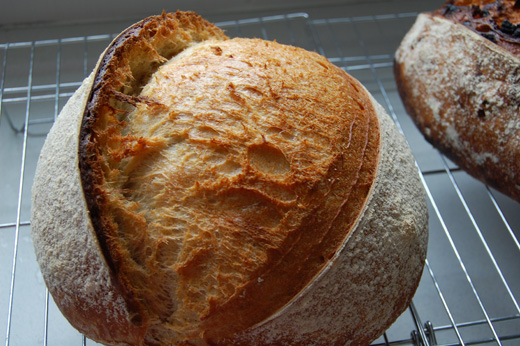
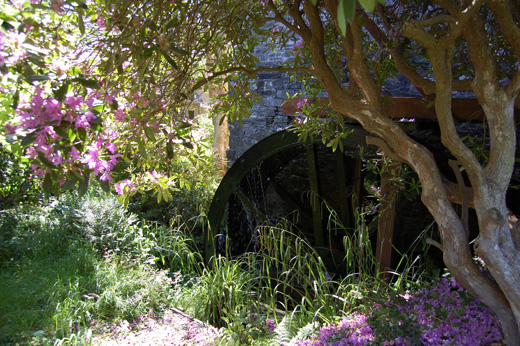
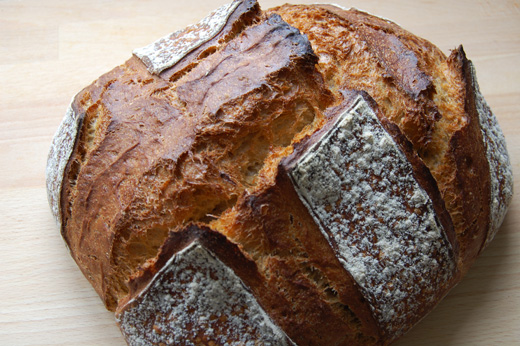



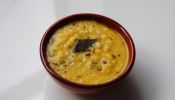


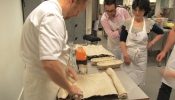














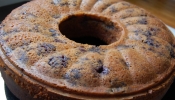


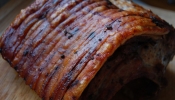

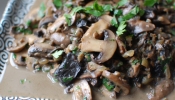

{ 6 comments… read them below or add one }
Fabulous post and thanks so much for all the mentions! I’m glad I could help. I love the pattern on the top of the loaves, just beautiful. Very excited that you are making these breads. I know exactly what you mean by that feeling of trying to wash it off your hands too, it takes ages, it feels like a hand cream that has emulsifed almost
Elizabeth David had a bit to say on bread tins – big quote here http://www.foodtimeline.org/foodbreads.html about half way down – until the 18th C no mention is made of baking in tins and then it is an English and Dutch thing mostly. I wonder if it had anything to do with the Earl of Sandwich 1718 – 1792 ? Probably not, more to do with the installation of domestic coal ranges with ovens in people’s homes as she writes in the quote referenced above. Well worth picking up a copy of ED’s book as it is a great read!
Isn’t that interesting, but then I love all food history!
It was a blessing reading your formula because had I not read the bit about how it should look like a cake batter I would have thought I did something wrong…so glad I had your notes on it. Was very pleased with the texture, not brick-dense-like at all. Next one will be a yeast and then will try a sourdough version again and split the loaves up so one is baked after a shorter rest period just to see what difference I get if any.
I should do a post really on “The reason I can bake good bread is because I bother other bakers for advice..”
Your loaves look very nice to me. Rye sourdough is all I make as it is so quick and easy. It makes excellent sandwiches and really good toast. I don’t knead it at all, just mix it with a spoon and bake it in a tin
Hi Choclette – I will be making these again in this shape but also in tins.
I love rye bread and have made it occasionally with a mix of rye and white flour. I suddenly remembered the lovely Borodinsky bread that I buy from Booths in the north west and is made by the Village Bakery in Cumbria. I have just done a search for this bread and found a mention of it on your blog, Joanna, which dates back to 2007!
http://joannasfood.blogspot.com/2007/04/borodinsky-bread.html
I’m glad that you enjoy yours so much, Azélia and I do love the top of the loaf!
I will attempt to make this soon, but might use Choclette’s no knead method!
Well the good think about 100% rye flour is you don’t knead just mix it all together and leave it.